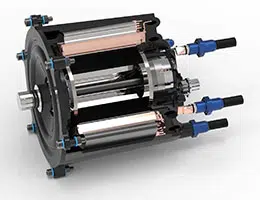 A motor is a device that, from an energy source , can generate movement . Electric , meanwhile, is that linked to electricity : the force manifested by the rejection or attraction between particles that are charged.
A motor is a device that, from an energy source , can generate movement . Electric , meanwhile, is that linked to electricity : the force manifested by the rejection or attraction between particles that are charged.
Electric motors , in this way, are machines capable of converting electrical energy into mechanical energy for the development of work. Some models also perform the reverse process, transforming mechanical energy into electrical energy.
A motor of this type can be powered by alternating current or direct current sources. Their use is very varied: electric motors are used in watches, drills, cars, trains and submarines, for example.
Alternating current (whose abbreviation in Spanish is AC ) is that in which the magnitude and direction change cyclically. Its developer was Nikola Tesla , a well-known engineer and inventor born in the mid-19th century in the Austrian Empire, who transferred all the patents to the North American company Westinghouse Electric to receive the necessary funds to continue its research and development .
Direct current ( DC ), on the other hand, is a continuous flow of electrical charge that passes through a conductor, from one point to another with different potentials and electrical charge, and that does not vary over time. Simply put, it differs from alternating current because its electrical charges do not change direction.
There are three types of alternating current motors: universal, synchronous and asynchronous. The latter is the most used at an industrial level, and the one that requires the least amount of maintenance . The universal electric motor is also called single-phase and can operate with various types of current. Its polar cores and circuit are constructed from iron to silicon and are stacked to minimize power loss.
The asynchronous electric motor is characterized by the fact that the magnetic field of the stator and the rotor rotate at different speeds. In the case of synchronous , the rotation of its shaft is synchronized with the frequency of the supply current.
With respect to the direct current electric motor , there is a classification according to the way in which it is connected, and this gives us the following types: series, compound, shunt and brushless electric. In electronics, in addition, the stepper, the servomotor and the coreless are used.
 Series is also called series excitation and has a constant voltage but an excitation field that increases with load. The compound has two inductor windings that cause the excitation of the current. The shunt has the winding connected in parallel with the winding circuit . The brushless one dispenses with these to change the polarity of the rotor.
Series is also called series excitation and has a constant voltage but an excitation field that increases with load. The compound has two inductor windings that cause the excitation of the current. The shunt has the winding connected in parallel with the winding circuit . The brushless one dispenses with these to change the polarity of the rotor.
Although the characteristics of electric motors are different depending on their class, in general it can be said that they use a magnetic field to transform electricity into mechanical energy capable of producing movement. Among the advantages they offer over combustion engines are the fact that they do not emit polluting substances and the low demand for external ventilation and cooling.
A car equipped with an electric motor, in this framework, stores electrical energy in rechargeable batteries . The electric motor provides instant torque and offers the vehicle great efficiency.
Compared to a "conventional" car fueled by gasoline (gasoline), diesel (diesel or diesel) or compressed natural gas (CNG), the car equipped with an electric motor is quieter and more environmentally friendly : when driving, it does not emit pollutants. In any case, it must be taken into account that electricity generation can pollute and affect the environment .
